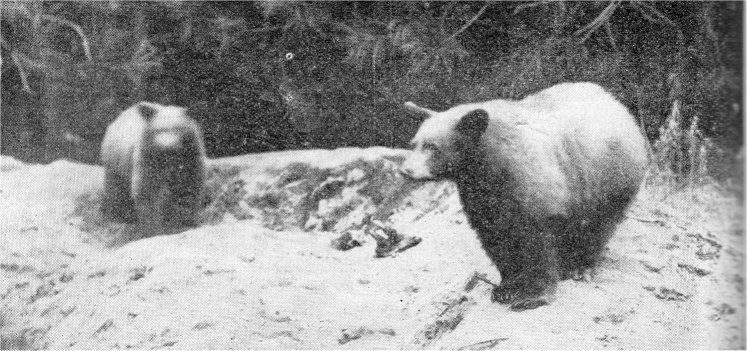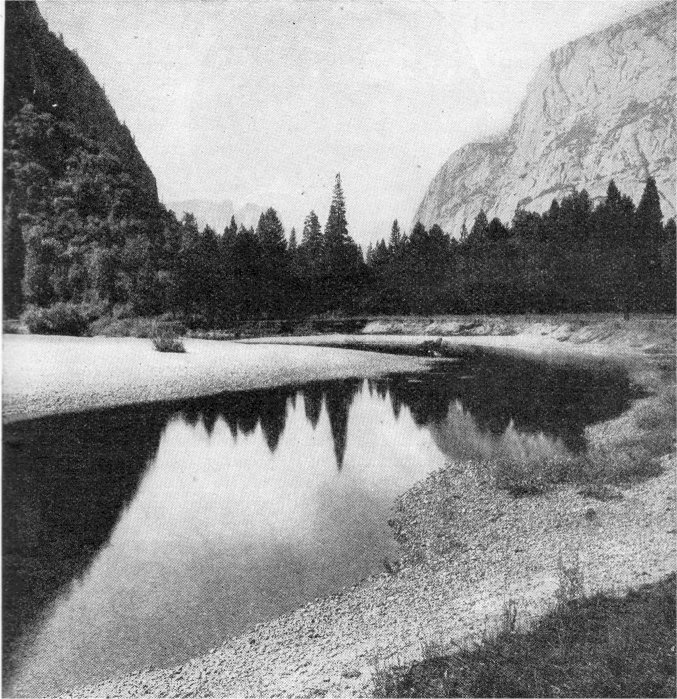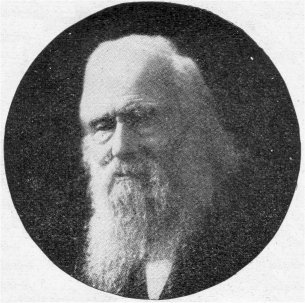Yosemite > Library >
Yosemite—Past & Present >
YOSEMITE—PAST AND PRESENT
[Sunset (April 1909)]
By Galen Clark
The writer, who is over ninety years old, has resided in the great Sierra valley for over a half
century and was for many years its official guardian

DESCENDANTS OF THE ORIGINAL YO SEMITE (BIG GRIZZLY BEAR) STILL ROAM THROUGH THE DENSE
UNDERGROWTH ON THE FLOOR OF THE GREAT VALLEY
|
The
Yosemite valley was first discovered
and made known to the public by
Major James D. Savage and Captain
John Boling, who with a strong detachment of
mounted troops from what was known as the
Mariposa Battalion of Volunteers went with
friendly Indian guides to the Valley in March, 1851,
to capture and take the resident tribe
of Indians out and put them on the Fresno
Indian reservation.
The first improved trail for saddle animals
to Yosemite was made by a livery stable firm
in Mariposa, the Mann Brothers, in 1856,
from Mariposa by way of the South Fork of
the Merced river, crossing the stream at a
point now known as Wawona. In 1857 the
regular tourist travel to Yosemite may be said
to have commenced, although a few persons
had gone there in the previous years. All
parties at that time went with camping outfits.
The first house in Yosemite was built in the
fall of 1856 and was opened up the next spring
as a saloon for the entertainment of that class
of visitors who loved whisky and gambling.
The next year it was fitted up and used as a
restaurant. Several years later it was enlarged
and known as Black’s hotel. The first building
for a hotel was built in 1859, and is now a
part of the Sentinel hotel premises known as
the Cedar cottage.
Most of the early visitors to Yosemite were
Californians, and the number did not amount
to one thousand in any one season until the
completion of the Union and Central Pacific railroads.
Soon after that the number increased
to many thousands annually.
All the necessary supplies for the hotels and
other purposes were taken into the Valley by
pack mule trains from Coulterville and
Mariposa, a distance of fifty miles, until the
completion of the first wagonroads into
Yosemite in 1874.
The grand features and great variety of
Yosemite scenery were early and widely made
known throughout the civilized world, by pen
and press. public speech, paint brush, camera
and kodak. But no painting or photograph
gives its vivid, thrilling life expression. I
have seen persons of emotional temperament
stand with tearful eyes, spellbound and
dumb with awe, as they got their first view of
the Valley front Inspiration point, overwhelmed
in the sudden presence of the
unspeakable, stupendous grandeur.

DURING THE SPRING FLOODS, THE MERCED RIVER CUTS AWAY GREAT PORTIONS OF ITS
GRAVELLY BANKS
|
Since the completion of the Yosemite valley
railroad up the Merced river to El Portal, near
the western boundary of the Yosemite national park,
the Government is having some
excellent work done on the road leading up
into the Valley, and if ample means are
appropriated by the present congress the good
work will continue on up to the hotel, public
camps and around the Valley on the interesting
carriage drives. It is to be hoped that
the California delegation in congress may be
successful in getting liberal appropriations for
continuing, not only this good work, but all
other important work for the protection and
nracarvatinn of the scenic beauty of the Valley.
[ILLEGIBLE] has taken place in here
[ILLEGIBLE] from the control of the
native Indians. In the early years, when first
visited by white people, three-fourths of the
Valley was open ground, meadows with
grasses waist high, and flowering plants. On
the dryer parts were scattering forest trees,
pines, cedars and oaks, too widely separated
to be called groves, clear of underbrush, leaving
clear, open, extensive vision up and down
and across the Valley from wall to wall on
either side. The Indians had kept the Valley
clear of thickets of young trees and brushwood
shrubbery so they could not be waylaid,
ambushed or surprised by enemies from
outside and to afford no hiding places for
bears or other predatory animals, and also to
clear the ground for gathering acorns, which
constituted one of their main articles of food.

GALEN CLARK. THE DISCOVER
OF THE MARIPOSA GROVE
OF GIANT SEQUOIAS
|
At the present time there is not more
than one-fourth of the floor of
the Valley clear, open ground
as it was fifty years ago; nearly
all the open ground between
the large scattering trees is
covered with a dense growth
of young trees which also
extend out over hundreds of
acres of the dryest portion of
the meadow land. Every
pine tree on the floor of the
Valley, less than seventy-five
feet high, has grown from the
seed within the last fifty years.
During recent years considerable
work has been done in clearing
up the young growth of trees and brush-wood
to afford better views of the distant
scenery and to be better able to control
fires, which accidentally get started during
the dry season. In many localities where
the work of thinning out and trimming
up the young growth has been done, are
desirable clean, shady groves for camping
parties. There are still hundreds of acres
where this reclaiming work needs to be
continued to make the greater portion of the
Valley accessible to visitors, and to break up
the hidden retreats of bears which have taken
up their permanent residence at several points.
This last season an old female bear with two
cubs has had a free pass throughout the Valley
and has given ferocious chase to every photo
artist who has attempted to get a picture of
herself and family.
As this work of clearing up and reclaiming
a large portion of Yosemite valley is one of
great importance and national interest, it
should be done in accordance with plans
submitted by the best landscape engineers,
after a careful survey and study of the whole
field, so as to show all scenery, local and
surrounding, to the best advantage from the
carriage roads, private walks and local resting
places. Much of this work can be done at
very little expense; all the larger growth to be
cleared away can be cut into firewood
and readily sold to residents for the cost of
the cutting.
Another matter of paramount importance
is the protection of the
banks of the Merced river, as
it runs its winding, crooked
course through the length of
the Valley. In the spring,
when the flood waters from
the melting snow on the
surrounding heights pour
over the great falls and fill
the river channel to overflowing
in many places, the strong
current impinging against the
gravelly substratum cuts it away
and undermines the top surface
grass sod, leaving it a loose
deathtrap for man or beast that
goes near its edge, until it breaks down of
its own weight. A space several feet in
width is cut away annually. During the
past thirty years the river channel in many
places has changed sidewise three times its
original width, leaving a wide, barren waste
of sand and gravel on the opposite side, thus
destroying its original beauty.
It may be interesting to the public to know
the cause of there being in recent years so
much more activity in the river currents than
during the earlier known history of Yosemite.
When the El Capitan iron bridge was built
in 1870 it was located across the narrow
channel of the river between the two points
of what retrains of an old glacial terminal
moraine. The river channel it this place was
filled with large boulders, which greatly obstructed
the free outflow of the flood waters
in the spring, causing extensive overflow
of the low meadow land above, and greatly
interfering with travel, especially to Yosemite
falls and Mirror lake. In order to remedy
this matter the large boulders in the channel
were blasted and the fragments leveled down
so as to give a free outflow of the flood waters.
This increased the force of the river current,
which now commenced its greater eroding
work on the river banks, and as the winding
turns become more abrupt the destructive
force annually increases. Some thorough
system of protection should he promptly used
to save the river banks from further damage.
Bibliographical Information
Galen Clark (1814-1910)
“Yosemite—Past and Present,”
Sunset 22(4) (April 1909), pp. 394-396.
Illustrated.
Digitized by Dan Anderson, December 2004,
from a copy at UCSD.
These files may be used for any non-commercial purpose,
provided this notice is left intact.
—Dan Anderson, www.yosemite.ca.us
http://www.yosemite.ca.us/library/yosemite_past_and_present/


